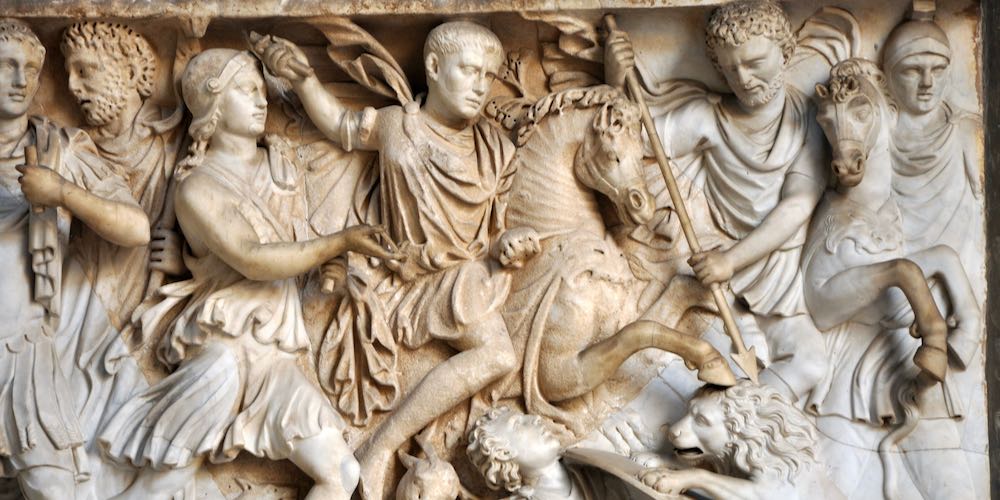The very ideologues who claim that we must be kind are not inclined to be kind to their political opponents—for with them, compassion is merely rhetorical.
Winning Like a Roman
What is the grand strategy of the United States? Historian James Lacey believes it can be identified in the Declaration of Independence and the Constitution’s Preamble. Universal equality, domestic Tranquility, unalienable rights, and the Blessings of Liberty have been America’s “national grand strategy” from its inception, with occasional recapitulations as required by changing circumstances. Lacey, who has written extensively about American strategy in World War II, adds that FDR’s Four Freedoms became the “strategic phrasing” of World War II.
This was the modern parallel provided in Lacey’s new book Rome: Strategy of Empire as he set about to explain the grand strategy of Rome. As this example illustrates, the book struggles with analytical imprecision, but before examining this, I must first acknowledge the book’s merits.
The book takes up the question posed by Edward Luttwak’s Grand Strategy of the Roman Empire in 1976. Luttwak made an argument for what Rome’s grand strategy might have been, but since that time scholars have wrangled more over whether any such grand strategy existed. Grand strategy as a concept is already fraught with controversy in political science circles, and historians are skeptical that premodern states had the administrative capacity for it. Luttwak also suffered criticism from his classicist detractors, who were animated perhaps as much by the fact that he wasn’t a classicist as by their disagreements with his conclusions. Like Luttwak, Lacey is not a specialist, but a self-described historian “whose research and writing range from Plato to NATO.” Nonetheless, Lacey asserts that Rome did in fact engage in sophisticated strategic thinking, and his book is a fine introduction to the topic that should reshape the debate.
Strategy, whether grand or otherwise, is not a modern concept, even if the language used is a product of the Enlightenment. Lacey argues that strategy “is always and everywhere a matter of ends, ways, and means, as seen through the prism of ‘risk.’” It is “the bridge between an established policy and the military aims necessary to achieve it.” Long before Rome’s empire, Aristotle had already established that political leaders must be familiar with “ways and means, war and peace, national defense, imports and exports, and legislation,” meaning that strategic thinking is an ancient concept. Even if Luttwak was wrong in some of the historical details he mustered, Lacey believes his detractors have taken their criticisms too far when they doubt that anyone before the Enlightenment was capable of strategic thinking.
In fact, Lacey argues, the Romans might just be the best example of ancient strategists. The empire “spent as much as four-fifths of its tax revenue on a 450,000-man army, building and maintaining three thousand miles of fortified frontiers (limes), supported by tens of thousands of miles of military roads; and conducted hundreds of prolonged military campaigns.” Rome’s empire was a political system not only capable of strategy, but that excelled in executing it. Lacey explains how, contrary to the consensus of scholars in such prestigious venues as The Cambridge Ancient History, Rome exhibited the qualities of strategy. Romans had extensive knowledge of geography. They manned fixed frontiers with fortifications, walls, and shrewdly located legions. They had the ancient approximation of a general staff centered around the imperial court. There is even evidence that they had policy statements, as seen in sources like the statesman Cicero, the historian Tacitus, and the administrative document the Notitia Dignitatum.
Lacey dedicates chapters to the empire’s finances, infrastructure, army, and navy before moving into a chronological survey of Rome’s strategic history. His knowledge of the principles of warfare, economics, and the organizational challenges of financing and managing frontiers and large armies shed light on Roman political and military history. The empire controlled the Mediterranean with its navy and held enemies at bay along the frontiers so that Roman towns with their respective infrastructure like aqueducts and canals could continue to flourish. Binding all of this together were the Roman roads, designed with the army in mind but incredibly beneficial to every form of commerce. Rome’s overarching strategy was the protection of this economic core. Rome kept enemies on the far side of the frontier—or bogged down by walls and small units there—until Roman armies using roads and rivers could speedily engage enemy forces.
This strategy could only be maintained by a sound imperial center, meaning emperors with unquestioned legitimacy and firm control of the legions. Legitimacy, which was a combination of dynastic claims and military prestige, thus became a second aspect of Roman strategic thinking. When legitimacy came into question, the legions would devour one another in civil wars, leaving the frontiers unmanned and the economic core vulnerable. This proved to be a sporadic problem, but as long as legitimacy was restored quickly enough, the empire could keep chugging along. In the final centuries of the empire, dynastic legitimacy became the unsolvable dilemma. With Roman armies wasting time and resources fighting themselves, the frontiers were punctured repeatedly, the core was ravaged, the funds sustaining the legions dried up, and the empire fragmented.
All states must maintain the three elements of power seen in Roman history: secure “economic foundations,” “a military force second to none,” and “an inexhaustible supply of soldiers.”
I would encourage those interested in Roman strategic thinking, especially its critics, to read his narrative of the Roman Empire, which does a fine job telling the story of how Rome maintained its overarching strategy in light of changing international circumstances. Specialists may find reason to quibble with certain details or interpretations, but the overall argument deserves attention. As an argument about the Roman Empire’s ability to conceptualize and maintain an ongoing imperial strategy, the book succeeds and is highly recommended. It reinvigorates and reshapes the debate.
The book also seeks to provide insights for modern strategists and citizens. Here, the project becomes muddled. Lacey mostly operates as something approximating an offensive realist. He frequently presents states as black boxes in a constant process of expansion at the expense of their neighbors. All empires, Lacey argues, seek to “maintain the integrity and stability of the Empire,” “protect the Empire from external enemies,” and “expand the borders of the Empire when possible and profitable, but always with an eye to expanding the Empire’s influence where physical expansion was not possible.” Lacey’s frequent references to the United States and China indicate that he believes these qualities of offensive realism are as applicable to modern states as they had been to ancient Rome or Parthia.
Lacey’s conclusion sums up the “great lessons . . . for modern strategists,” namely that all states must maintain the three elements of power seen in Roman history: secure “economic foundations,” “a military force second to none,” and “an inexhaustible supply of soldiers.” Lacey misses the opportunity to explain how states can achieve these things. Returning to his black box theory, he frequently makes references to other states without regard to their internal dynamics, both ancient and modern. For example, in his final two pages he compares how Rome, early modern Britain, China, and the U.S. all tended to these elements, as if states are puppeteered by nondescript leaders pulling levers in favor of the economy, military capability, or manpower.
Lacey is not unaware of ideological impulses or shifts in Rome. He references Tacitus’ claim that the transition from republic to empire involved a “cheerful acceptance of slavery.” Elsewhere he states that the “Roman psyche still internalized the belief that Rome was meant to rule the world.” But for the most part, he is dismissive of the force of ideas, ideology, and morality. For example, several times he references the Roman Republic’s startling ability to field manpower against Carthage in the Punic Wars despite catastrophic defeats, but he ignores the republican ethos and way of life that provided that manpower. What impact would the loss of these republican mores have in the centuries following the turn to autocracy?
Another example is Lacey’s treatment of Christianity. He dedicates only a handful of paragraphs to the new faith, which in his eyes was merely a source for “discontentment” or “religious upheaval.” The “true danger” of Christianity, for Lacey, is that it was a distraction. Nowhere does he try to wrestle with why this upheaval occurred, how it challenged the Roman mind, how it undermined the historic ethos binding the empire together, and what the resulting shifts meant for Roman policy. These questions need answering because they bear heavily on a state’s strategic thinking and its ability to carry out any strategy. Edward Gibbon, the 18th-century author of the magisterial The History of the Decline and Fall of the Roman Empire, certainly engaged them.
In stark contrast to his offensive realist approach, Lacey is at times oddly ideological when referencing his own country. He bemoans the fact that the Roman Empire has no document of grand strategy like Jefferson’s Declaration or FDR’s Four Freedoms. But if we are to interpret those American statements as policies elucidating national strategic thinking, we need not search long through the pages of Cicero’s orations, Horace’s Odes, Virgil’s Eclogues, or Marcus Aurelius’ Meditations to find them. These Romans are, of course, not actually referring to grand strategy, but the imperial ideology that underpins Roman conquest, just as the Declaration, Preamble, and Four Freedoms are not statements of grand strategy but political creeds.
These creeds/ideological sentiments about Roman imperialism are not hard to find. We still have Cicero’s speech supporting Caesar’s genocidal conquests in Gaul because a Gallic province of the Roman Empire meant that Rome was secure and Gaul enjoyed the benefits of Roman law, justice, and citizenship. (Cicero conveniently glossed over Caesar’s atrocities in this case.) Cicero’s defense of Caesar took a more nuanced form in his treatises On the Republic and On Duties. Rome was a benevolent imperial mistress, Cicero argues, that only undertook war on behalf of its weaker allies, and its long legal and civic traditions ensured that those people grafted into the Roman tree would enjoy the fullness of Roman liberty.
Imperial ideology as seen in the writings of Virgil, Horace, and The Deeds of the Divine Augustus champion the first emperor, Augustus, as the messiah who would not only free Rome’s people from civil strife and restore the government, but also extend peace, justice, and prosperity to the world. Augustus was himself that savior. In his official “Deeds of the Divine Augustus,” the emperor claims that he restored liberty, cleared the seas, and became a father to Rome’s citizens by chasing Rome’s enemies “throughout the world.” Conceived as the “Age of Jupiter” or the “Saturnian Age,” court poets recast Rome’s imperial ideology for the emperor, who would “advance his empire . . . to a land which lies beyond our stars.” Rome had been chosen by the gods to rule the world and spread its laws and its peace.
Why does Lacey not identify statements such as these as Rome’s grand strategy? He seems confused about the difference between ideology and strategy. For Rome, these are two different things. For America, ideology equals grand strategy.
It is tempting to wonder if Lacey’s analytical imprecision reveals the confusion of American strategic thinking since the Cold War. Lacey has decades of experience in the American military-industrial complex, as an army officer, a war correspondent, a consultant, and a professor at the Marine Corps War College. He is a fair representative of strategic thinking since the Cold War, where the ideology of American democratism transmogrified into a grand strategy.
The Truman Doctrine articulated that “the free peoples of the world look to us for support in maintaining their freedoms.” It became “the policy of the United States to support free people who are resisting attempted subjugation by armed minorities or by outside pressures.” In his March 1961 address to Congress, President John F. Kennedy explained that “Any potential aggressor contemplating an attack on any part of the free world with any kind of weapons, conventional or nuclear, must know that [America’s] response will be suitable, selective, swift, and effective.” The scope was as broad as the battle lines were clear.
Kennedy’s successor, Lyndon B. Johnson, applied this logic in Vietnam because, in his words, “the issue is the future of southeast Asia as a whole. A threat to any nation in that region is a threat to all, and a threat to us.” Why was this the case? A joint resolution of Congress in 1964 answered this. “The United States regards as vital to its national interest and to world peace the maintenance of international peace and security in Southeast Asia.”
And when communism died, terrorism became the new idolatry confronting American democratism, which is why Presidents Bush and Obama were not content to punish terrorist cells or tyrannical supporters of terrorists. Americans needed to remake the countries that had harbored terrorists into liberal democracies, dedicating, reshaping, or expending Lacey’s three elements to do so: the economy, military capabilities, and manpower.
Biden is engaged in a similar effort today in Ukraine. “The battle for democracy could not conclude and did not conclude with the end of the Cold War,” he opined in March. In a manner Lacey would surely appreciate, Biden appealed to another author of American ideology, Abraham Lincoln. As Lincoln saved the Union from civil war, Biden must now assist the worldwide movement for democracy. Early America’s internal struggle with liberty and equality for all is now America’s grand strategy of promoting liberty and equality throughout the world.
Perhaps the most important lesson Lacey offers modern strategists, albeit unintentionally, is to beware of the conflation of ideology with strategy. Most Roman emperors understood that the Roman ideology of world domination was limited by strategic realities. Do American strategic thinkers, including Lacey himself, similarly understand that their political creeds may not be applicable, achievable, or even desirable elsewhere in the world?


